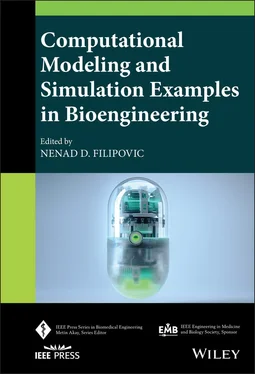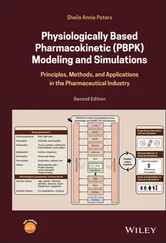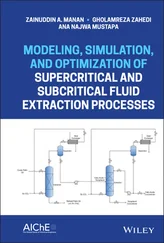1 ...7 8 9 11 12 13 ...16 (1.1) 
The left upper index “ t + Δ t ” denotes that the quantities are evaluated at the end of time step. The matrix M vis mass matrix, K vvand J vvare convective matrices, K μvis the viscous matrix, K vpis the pressure matrix, and F vand F pare forcing vectors. The pressure is eliminated at the element level through the static condensation. For the penalty formulation, the incompressibility constraint is defined in the following manner:
(1.2) 
where λ is a relatively large positive scalar so that p / λ is a small number (practically zero).
1.7.1 Displacement Force Calculations
Displacement force was calculated from direct integration of the pressure and wall shear stress distributions on the surfaces of the aortic wall:
 (1.3)
(1.3)
where the integrals are surface finite elements along the surface of the aortic wall. Weight of blood in standing or supine position was also considered. It was assumed that all of the weight of the blood is supported by the endograft.
1.7.2 Shear Stress Calculation
At the regions of stasis and flow reversals, there is an important role of motion and deformation in the shear stress calculation [110, 111], concept of the rigid wall condition was assumed due to the negligible effect of shear stress on total DF [112]. The distribution of stresses within the blood was estimated. The stresses t σ ijat time “ t ” is equal
(1.4) 
where
(1.5) 
is the viscous stress, t μ is viscosity corresponding to the velocity vector t vat a spatial point within the blood domain. The viscous stresses are represented by (1.5).
The wall shear stress is calculated as:
(1.6) 
where t v tdenotes the tangential velocity, and n is the normal direction at the vessel wall. At the integration points near the wall surface, the tangential velocity was estimated first, and then the velocity gradient ∂ t v t/ ∂n was calculated. Finally, the viscosity coefficient t μ using the average velocity was evaluated. Blood was taken as an incompressible Newtonian fluid, appropriate for larger arteries [110]. The kinematic viscosity was ν = 3.5e−6 m 2/s and the blood density was ρ = 1050 kg/m 3.
1.7.3 Modeling the Deformation of Blood Vessels
In modeling blood flow in large blood vessels, we have recognized two distinct cases: (i) rigid walls and (ii) deformable walls. The assumption (i) is mostly adopted in practical applications. It is very important to determine the stress–strain state in tissue, when blood and blood vessel system is analyzed, as well as the effects of the wall deformation on the blood flow characteristics.
There are complex mechanical characteristics of blood vessel tissue. The tissue can be modeled from linear elastic to nonlinear viscoelastic model. The governing finite element equations used in modeling wall tissue deformation with emphasis on implementation of nonlinear constitutive models are summarized.
If the principle of virtual work is applied, the differential equations of motion of a finite element are
(1.7) 
where the element matrices are: Mis mass matrix; B wis the damping matrix, in case when the material has a viscous resistance; Kis the stiffness matrix; and F extis the external nodal force vector which includes body and surface forces acting on the element. The dynamic differential equations of motion by the standard assembling procedure are obtained. These differential equations are integrated with a selected time step size Δ t . The displacements n + 1 Uat end of time step are finally obtained according to equation:
(1.8) 
where the tissue stiffness matrix  and vector
and vector  are expressed in terms of the matrices and vector in (1.7). Above equation is obtained under the assumption that the problem is linear: the viscous resistance is constant, displacements are small, and the material is linear elastic.
are expressed in terms of the matrices and vector in (1.7). Above equation is obtained under the assumption that the problem is linear: the viscous resistance is constant, displacements are small, and the material is linear elastic.
In many real examples as in case of aneurism or heart ventricle motion, the wall displacements can be large, hence the problem becomes geometrically nonlinear. Also, the tissue of blood vessels has nonlinear constitutive law which has to be expressed with materially nonlinear finite element formulation. Therefore, the linear formulation of the equation may not be appropriate. For a nonlinear problem, there is incremental–iterative equation
(1.9) 
Here, Δ U (i)are the nodal displacement increments for the iteration “ i ,” and the system matrix  , the force vector
, the force vector  , and the vector of internal forces n + 1 F int(i − 1)correspond to the previous iteration.
, and the vector of internal forces n + 1 F int(i − 1)correspond to the previous iteration.
We described the material nonlinearity of blood vessels which is used in further applications. The geometrically linear part of the stiffness matrix,  , and nodal force vector, n + 1 F int(i − 1), are defined:
, and nodal force vector, n + 1 F int(i − 1), are defined:
(1.10) 
Читать дальше



 (1.3)
(1.3)




 and vector
and vector  are expressed in terms of the matrices and vector in (1.7). Above equation is obtained under the assumption that the problem is linear: the viscous resistance is constant, displacements are small, and the material is linear elastic.
are expressed in terms of the matrices and vector in (1.7). Above equation is obtained under the assumption that the problem is linear: the viscous resistance is constant, displacements are small, and the material is linear elastic.
 , the force vector
, the force vector  , and the vector of internal forces n + 1 F int(i − 1)correspond to the previous iteration.
, and the vector of internal forces n + 1 F int(i − 1)correspond to the previous iteration. , and nodal force vector, n + 1 F int(i − 1), are defined:
, and nodal force vector, n + 1 F int(i − 1), are defined:











